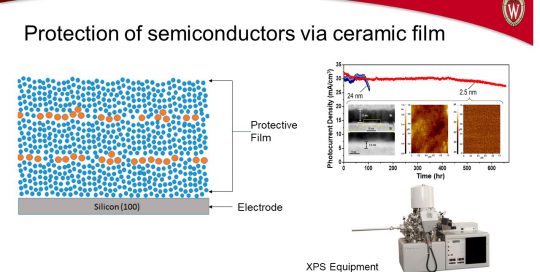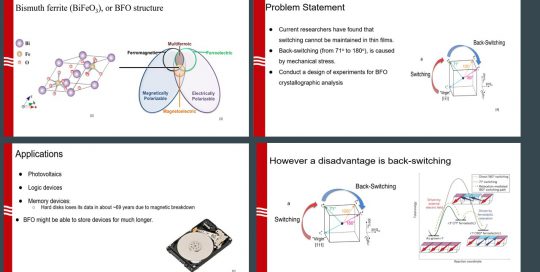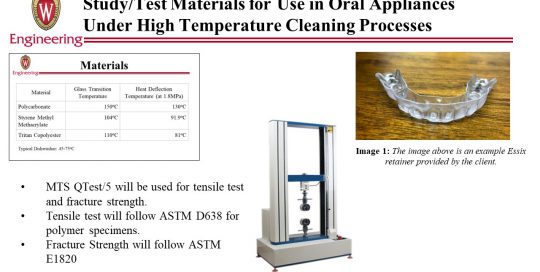Project Overview: The most efficient and precise way to join steel rail together is through flash butt welding. It offers a filler less and solid-state solution to joining rail together that provides numerous advantages to mechanical-joining. The weld is the weakest part of the rail, and frequently is the root of failure when it occurs. [...]
An Investigation of Sintering Process to Prevent Incomplete Sintering of 3D Printed Manufactured Parts
rehaas2020-05-26T10:42:04-05:00Project Overview: Small metal parts are being manufactured using a 3D printer with a powder metal filament, and then the parts are sintered (compacted and formed a solid mass of material) in a furnace. The current sintering process used by The Virtual Foundry has some issues with incomplete sintering and oxidation of small metal parts. [...]
Investigation of amorphous oxide film protection of Silicon (Si) photo electrochemical photanode
rehaas2020-05-26T10:42:23-05:00Project Overview: A photo electrochemical electrode uses sunlight to split water into hydrogen and oxygen which then can be used as an energy source. Typically, silicon is used as the photo electrochemical electrode, but it degrades quickly when exposed in the corrosive electrolyte. To combat this corrosion, silicon can be shielded from the outside environment [...]
Computational Design and Demonstration of Voltage Control of Magnetic Skyrmions
rehaas2022-04-13T10:40:13-05:00Project Overview: In physics, Magnetic skyrmions (MS) are quasi-particles which have been predicted theoretically and observed experimentally in condensed matter systems. Magnetic skyrmions, named after British physicist Tony Skyrme, can be formed in a magnetic thin film (<10 nano-meters). Magnetic skyrmions are small swirling topological defects in the magnetization texture. MS are thermally stable and [...]
Investigation of Thickness dependent back-switching in Monodomain Bismuth Ferrite (BiFeO3) Thin Films
rehaas2020-05-26T10:43:07-05:00Project Overview: The nature of back-switching in BiFeO3 was revealed using monodomain epitaxial thin films with different orientations. Current researchers have found that switching cannot be maintained in thin films. Back-switching (from 71o to 180o) is caused by mechanical stress and is countered by ferroelastic relaxation. This project will conduct a design of experiments for [...]
Study/Test Polymeric Materials for Use in Oral Appliance under High Temperature Cleaning Processes
rehaas2020-05-26T10:43:27-05:00Project Overview: Polycarbonate (PC), styrene methyl methacrylate (SMMA), and copolyesters (Triton) are transparent polymeric materials with strong heat resistant properties. Alongside the strong thermal properties, they possess the preferred optical and mechanical properties fit for that of an oral retainer. These materials, though not necessarily used in current dental applications, are used in medical applications. [...]
Developing Engineering Mechanical Design Values for Wooden Nails
rehaas2020-05-26T10:43:44-05:00Project Overview: Nails are the most common mechanical fastenings used in wood construction. Typical wooden nails are made from indigenous beech wood and boast a tensile strength similar to aluminum nails. Withdrawal strength is an important mechanical property for nailed connections and currently there is no published data on the withdrawal strength of these nails. [...]
Investigation of Sintered Titanium-Ceramic Metal Matrix Composites
rehaas2020-05-26T10:44:00-05:00Project Overview: The goal of this project is to create a metal matrix composite of titanium with ceramic fiber reinforcement that has superior properties and a lower density than pure titanium produced with the same method. The high specific strength and low density of Ti metal matrix composites is of extreme importance for high materials [...]
Developing Improved Carbon Nanotube Processing and Chemistry Methods for Field Effect Transistor Biosensor Application
rehaas2020-05-26T10:44:18-05:00Project Overview: Electrochemical biosensors are currently among the most popular of the various types of biosensors. Currently, the Arnold research group has a method to deposit aligned carbon nanotubes (CNTs) on silicon wafers for use in biosensors. However, the current position method is limited to wafers with a square geometry and does not coat to [...]
Investigation of Cold Spray Coating Applications for the Repair of Stress Corrosion Cracking (SCC) in Dry Cask Spent Nuclear Fuel Storage
rehaas2020-05-26T10:44:34-05:00Project Overview: Spent nuclear fuel (SNF) storage in dry casks experience stress corrosion cracking (SCC) when stored for long periods of time in corrosive environments. Repair of SCC is needed in order to maintain the structural integrity and safety of the dry casks. Cold spray has been identified as a promising, scalable solution to the [...]










